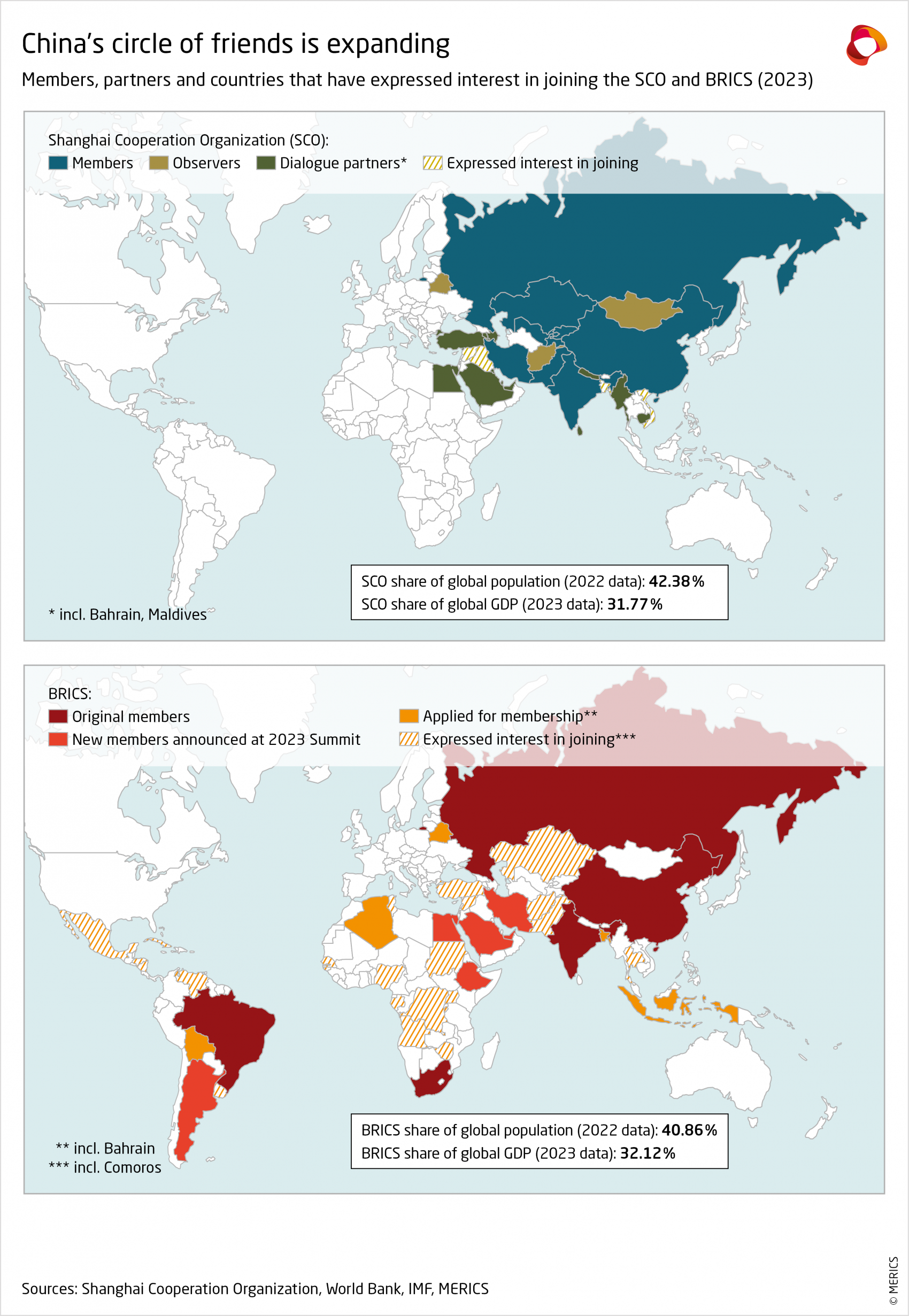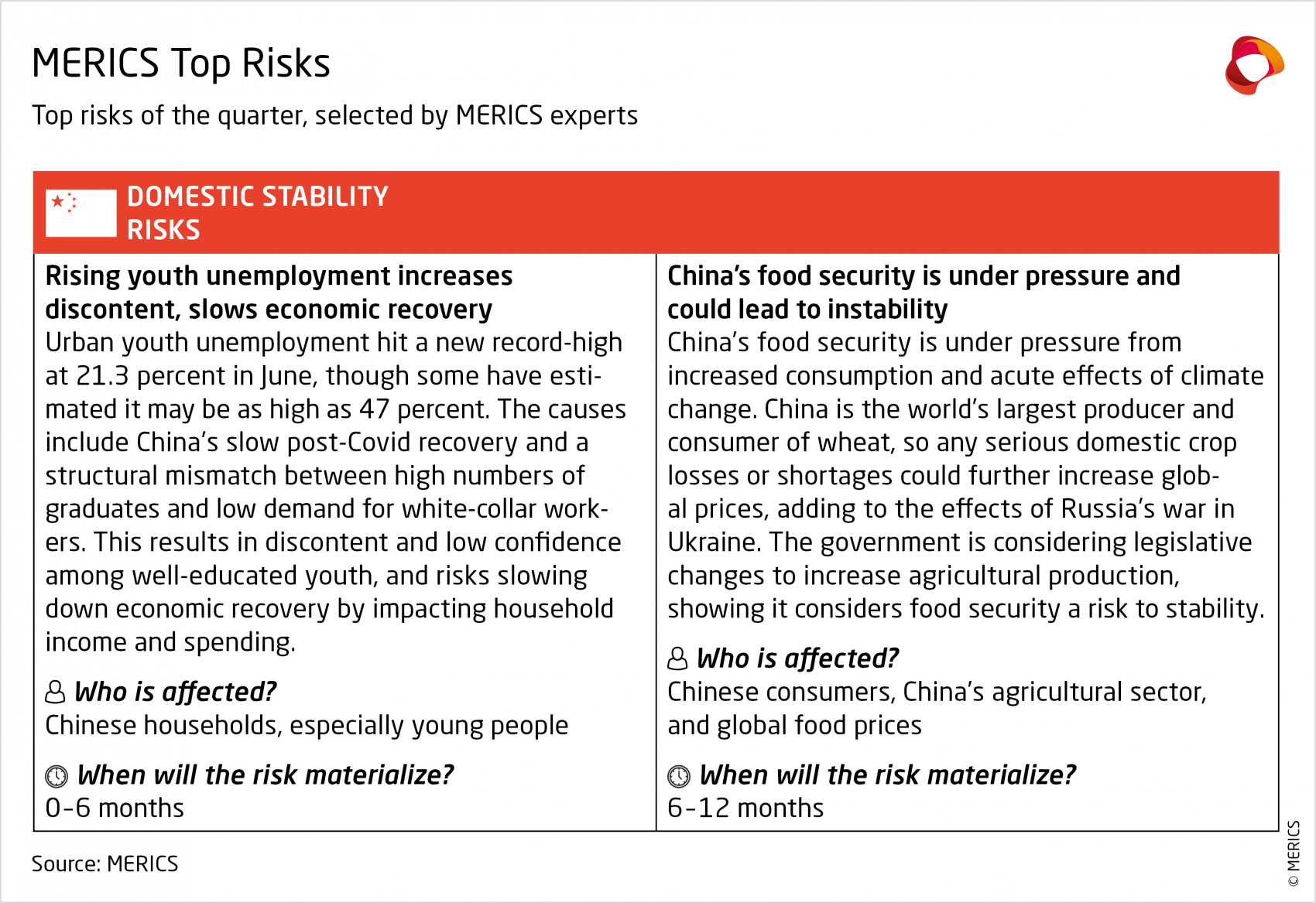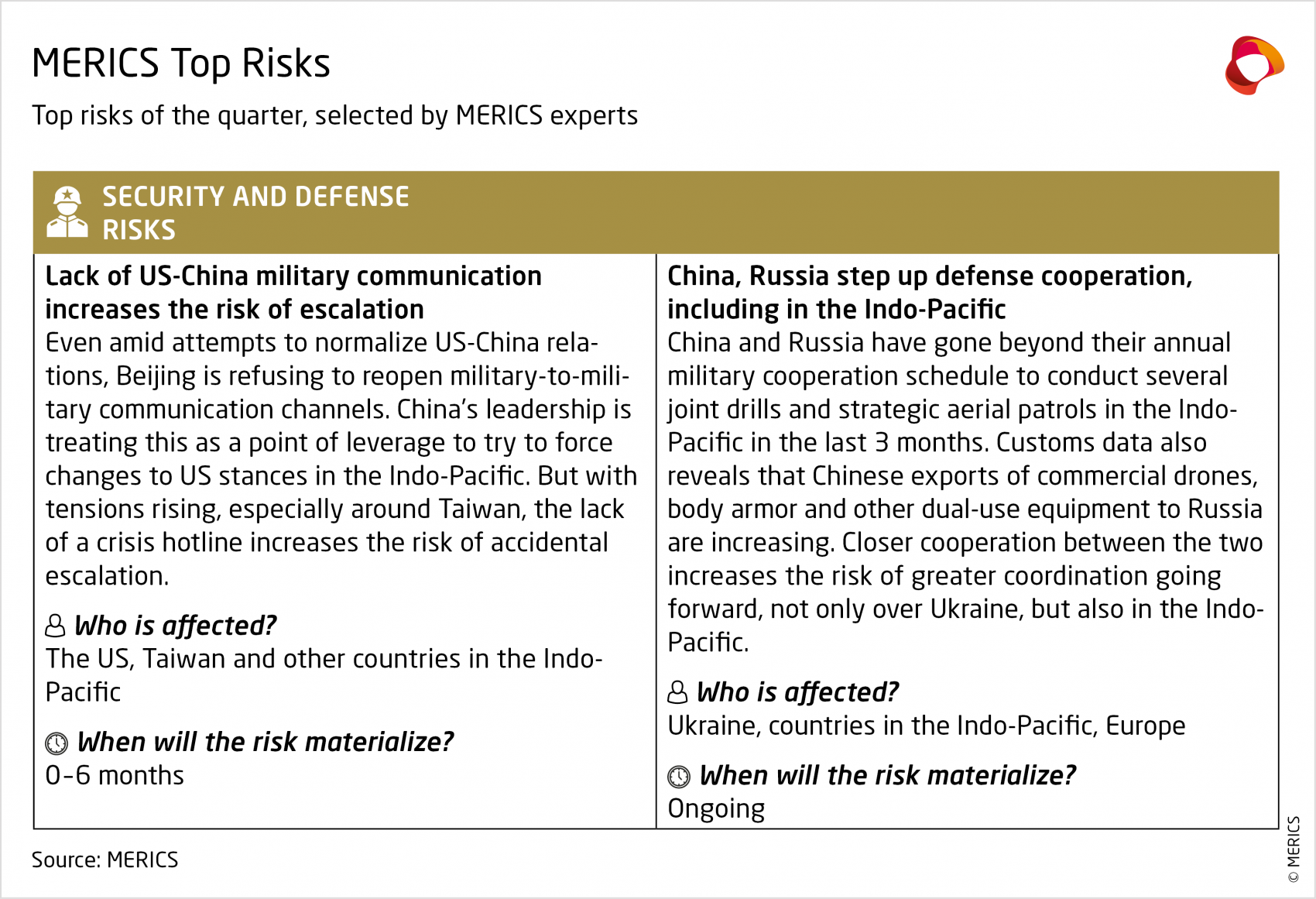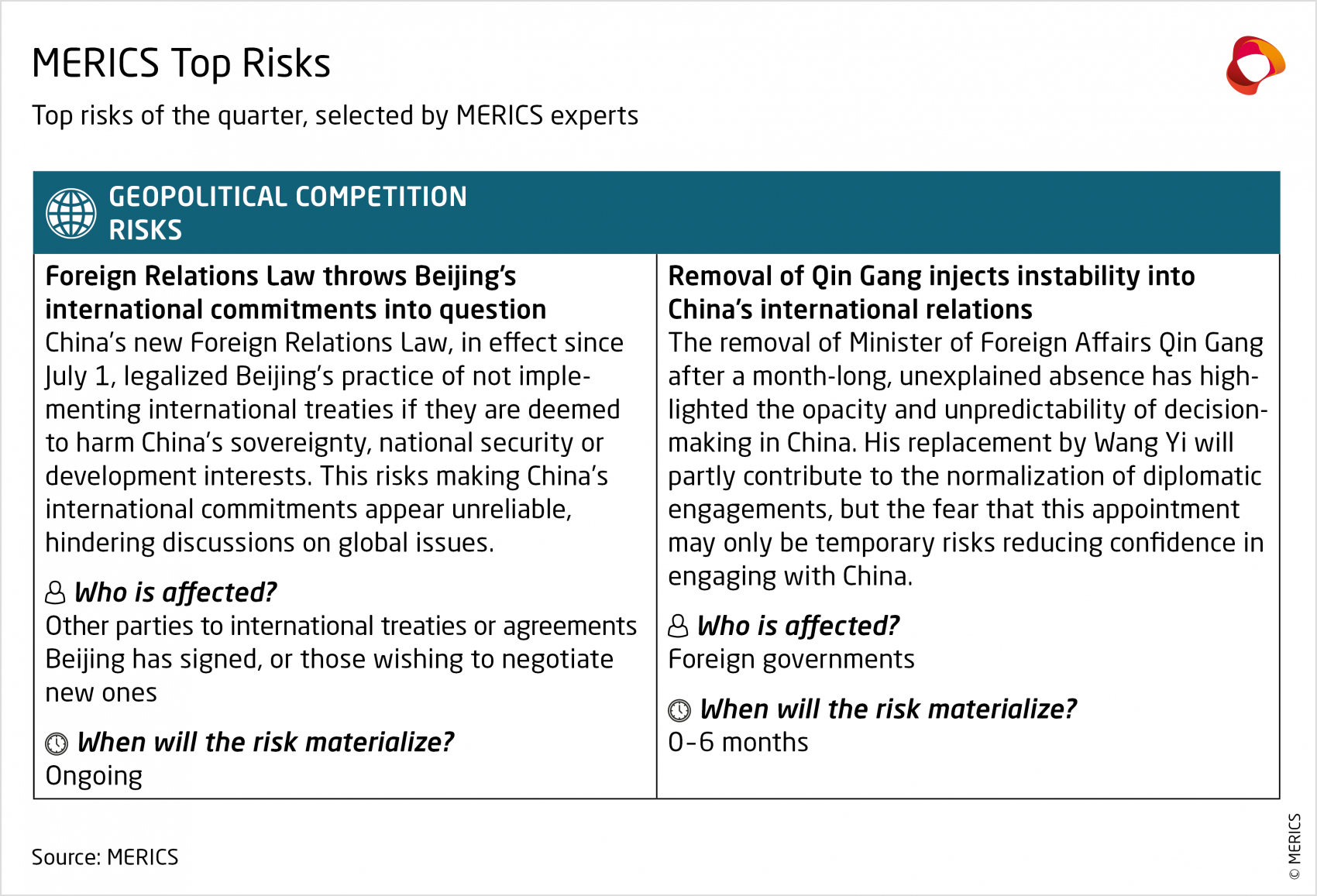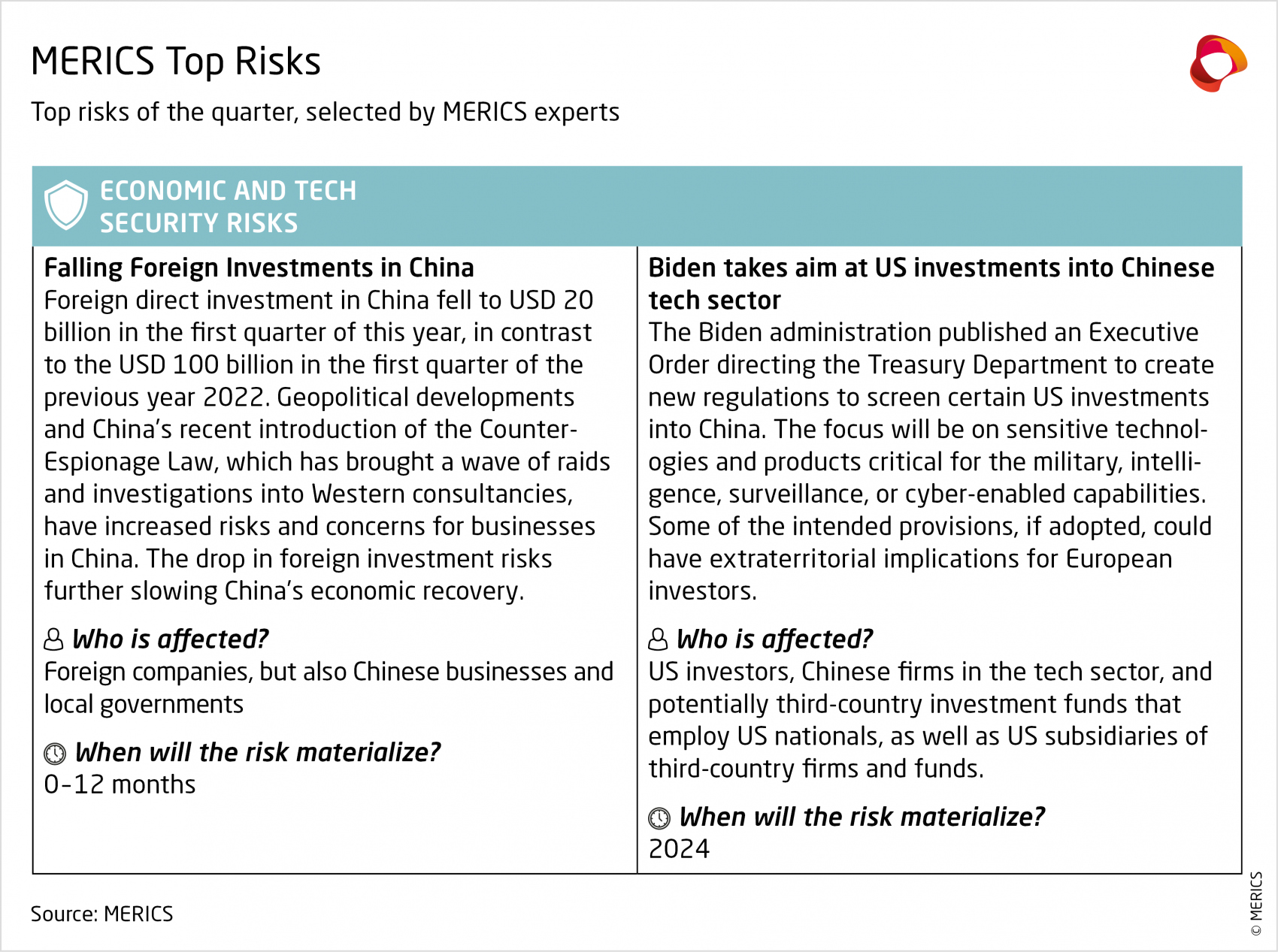
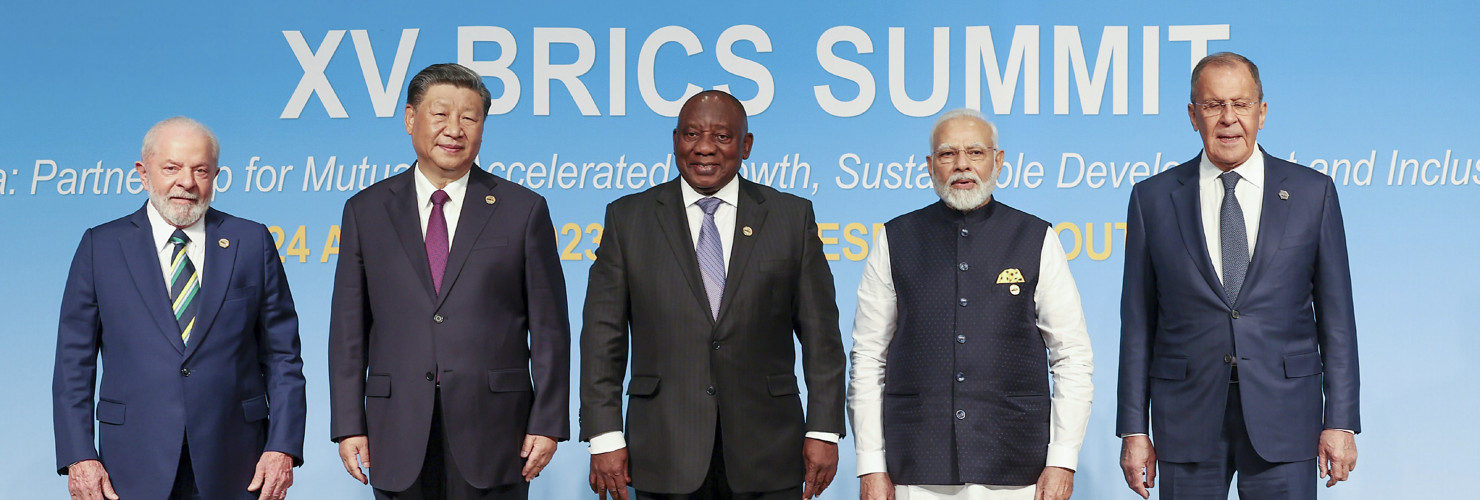
MERICS China Security and Risk Tracker 03/2023
Focus Topic
China pushes to expand the SCO and BRICS
by Helena Legarda
To build a counterweight to international institutions seen as too Western-dominated, Beijing wants to expand the BRICS grouping and the Shanghai Cooperation Organization (SCO). Chinese officials expressed strong support for adding new members to both organizations in the months leading up to two summer summits – the July SCO summit hosted by India (whose full members are four ex-Soviet border states plus India, Pakistan, Russia, China and now Iran)1 and the August BRICS summit of Brazil, Russia, India, China and South Africa in Johannesburg.2 Beijing’s efforts within BRICS were successful. At the summit in South Africa, the group announced six new members that will join starting January 1, 2024: Argentina, Egypt, Ethiopia, Iran, Saudi Arabia and the UAE.
Beijing’s push to expand BRICS and the SCO shows it puts renewed importance on these multilateral fora amid worsening geopolitical competition with the United States. They form part of its drive to strengthen ties with nations in the Global South. Beijing, and Moscow, are actively reaching out to countries that do not see themselves as important players in the current order to offer an alternative and a counterweight.
The SCO and BRICS are attractive fora for developing countries
The BRICS and SCO are often dismissed as little more than talking shops with no clear identity or agenda. Yet the fact that dozens of countries, such as Bangladesh, Argentina or Indonesia, are reportedly seeking to join either or both groupings confirms their attractiveness.3
The SCO has a particular focus on expanding in the Middle East, while BRICS is also targeting nations across Africa and Latin America. Becoming part of a smaller club of non-Western countries with growing influence, where their voices are likely to carry more weight, is an attractive proposition for many developing economies seeking to increase their global status.
Unconstrained by agreed norms and principles, the two groupings can serve as a diplomatic and geopolitical lifeline for members who find themselves internationally isolated. Moscow has benefitted greatly from this since launching all-out war in Ukraine in February 2022. Barred from traveling to much of the Western world, Russia’s President Vladimir Putin’s international trips in 2022 were mostly to other SCO member countries. And both the SCO and BRICS have emphasized that he will not be uninvited from their summits – a fact that Moscow has used to criticize the West’s failure to isolate Russia.
However, potential members are motivated by positive opportunities too. As BRICS cooperation gathers pace and the SCO’s focus expands from security to energy and economic issues, they hope that membership will generate economic opportunities and privileged access to China. Amid talk of diversification and de-risking in Europe and the United States, the pull of China’s market remains strong across the Global South.
Costs to membership exist, but they are outweighed by the benefits
The climate of geopolitical competition means joining BRICS or the SCO may carry costs. First, neither organization can provide full alternatives to existing alliances or multilateral organizations. BRICS may have the ambition of becoming an alternative to the G7,4 advancing initiatives like the New Development Bank or the BRICS payment system. But the SCO is neither a security provider nor an alliance, and shows no intention of becoming one. The duo are, for now, forums for dialogue and the expansion of bilateral ties and operate mostly in the normative and geopolitical space.
Many developing countries may find themselves in a difficult balancing act between closer engagement with the SCO and BRICS and preserving their vital security and economic ties with Western partners. Turkey is an example here, a NATO ally that has faced strong pushback over its stated ambition to join the SCO.5
The balancing act may have been easier in the past, but worsening geopolitical competition and deepening mistrust are making it harder. China’s role in these organizations has long been a source of concern for Western nations. But the war in Ukraine means tensions have also begun to emerge over Russia’s role and presence.
For instance, South Africa felt the pressure as it prepared to host this year’s BRICS summit. Pretoria spent months equivocating on whether Russia’s President Vladimir Putin would attend in person. The existence of an International Criminal Court (ICC) arrest warrant for Putin put the South African government in a bind. As a signatory of the Rome statute, Pretoria is legally obliged to arrest individuals indicted by the ICC, so failing to do so would make South Africa look like it was taking a clear geopolitical side. But uninviting Putin could damage its ties with the rest of the BRICS group.6
Moscow and Pretoria eventually agreed Putin would not attend in person. But there are clearly costs associated to appearing too close to China or Russia – and by extension to the BRICS or SCO. However, the benefits of joining seem to outweigh any costs for many nations.
Rapid expansion is risky for China and the groups themselves
Not all members are equally keen on expansion. Within BRICS, India and Brazil seem especially wary of a bigger pool that would dilute the power and say of existing members.7 Despite these concerns, an expansion of the group was agreed upon at the South Africa summit. China’s expansion drive, however, might antagonize some, worsening the internal dynamics.
Risks also lie in recruiting countries with unresolved bilateral issues (as with India and Pakistan within the SCO) as this could block consensus and hinder action. The SCO has found a workaround to internal tensions by issuing statements or strategies not signed by all members.8 But this is not a sustainable solution in the long run.
As the EU can attest, rapid expansion can also create difficulties in crafting an organizational identity, ideology and overarching goal amid new national interests and areas of concern. Although neither SCO nor BRICS members are currently joined together by a common ideology, they do share a desire to play a greater role in a reformed global order that better reflects and responds to the needs of emerging economies.
The way forward for Europe
As part of China’s push to build a network of “like-minded partners”9 in the Global South and reform the global order, BRICS and the SCO also have a role in disseminating policies, concepts and approaches that clash with European interests and values.
Beijing is actively pushing the Global Security Initiative (GSI) and Global Development Initiatives (GDI) within these bodies to propagate its approach to global security and view of the security-development nexus (i.e., security as a precondition for development). Beijing previously succeeded in exporting its concept of the “three evils” of terrorism, separatism and extremism, making it a core task of SCO in 2001.10 This extremely broad slogan is used to promote and justify repression in Xinjiang and to rally support among China’s western neighbors.
Russia’s diminished international status means China could become the main rule-setter in groups that represent a large percentage of the world’s population and economy. Already, both BRICS and the SCO (separately and without taking into account membership overlaps) represent more than 40 percent of the world’s population and more than 30 percent of global GDP.
Europe must not lose sight of this trend. Many countries in the Global South see membership of these groups as an opportunity for a louder international voice, even if they do not share all their values. The EU would do well to acknowledge these concerns and do more to become a more attractive partner. should dedicate more resources to strengthening its partner relationships globally, and move beyond the dichotomy of democracies versus authoritarian states, to prevent further fragmentation of the global order.
Key developments of the quarter
Domestic stability
Socio-economic instability grows due to Covid-19 effects
China’s slow recovery from its strict zero-Covid policies is piling up socio-economic stress, from rising inequalities, high unemployment rates and increasing pressure on households.
Young people especially are losing confidence in their future, faced with record youth unemployment (21.3 percent in June, after which the National Bureau of Statistics said it would suspend publication of urban youth jobless data), unattractive working conditions, an unsustainable housing market and rising prices. The poor outlook has prompted many households to economize, slowing the economic rebound.
China’s ageing population puts additional pressure on its social system. Families shoulder the burden of care, putting a disproportionate extra workload onto women and limiting their capacity to work full-time. Many decide against having one or more children, which further exacerbates demographic change.
Long debt-burdened local governments have amassed an estimated EUR 20 trillion of debts from unsustainable spending and Covid-related costs. Some have resorted to cutting or suspending employee pay, while others are franchising out public services. Social services are suffering budget cuts, which will impact the most vulnerable groups in society most.
The government sees these issues as a top priority, as recent Politburo meetings have made clear, but measures to tackle them remain insufficient. Current risks are likely to be exacerbated, as wealth gaps and societal dissatisfaction increase while consumption continues to slump. The CCP’s Third Plenum, in the fall, will require the government to address these issues since it is a key forum for socio-economic planning. President Xi Jinping’s vision of “common prosperity” depends upon solutions to these problems.
Security and Defense
Beijing tries to weaken NATO consensus on China
On July 11, NATO leaders gathered in Lithuania for their annual summit. While the war in Ukraine dominated the discussions, this year’s summit also confirmed NATO’s new focus on China and the Indo-Pacific. The “Asia-Pacific Four” – NATO’s four partners in the region: South Korea, Japan, Australia and New Zealand – were once again invited to attend. And the China-related language in the communiqué was more extensive than ever – a sharp change given NATO first mentioned China in a summit communiqué in 2019.
The communiqué singled out China’s malicious hybrid and cyber operations, disinformation, efforts to amplify Russia’s narratives, and attempts to control key technological sectors and supply chains as concerning actions. There is an ever more solid consensus among all 31 NATO allies regarding China risks, and hence a theoretical foundation for the development of collective approaches and responses going forward.
Reaching agreement on further steps will not be easy. There are fault lines within the alliance on this point. Beijing is aware of them and actively trying to exploit them. Chinese commentaries welcomed France’s decision to block the establishment of a NATO liaison office in Japan, praising President Emmanuel Macron’s “strategic sobriety” and urging greater European strategic autonomy. Beijing’s criticism of the summit language zeroed in on the United States: it cited NATO’s damage to Europe and Washington’s hand in instigating a “Cold War mentality and ideological prejudice”.
Beijing sees European members of NATO (or some of them) as holdouts when it comes to the alliance’s China policy. They are therefore targeted in China’s diplomatic overtures. Debates over what part NATO should play in response to Beijing’s changing international behavior will continue, given there are different national interests, views of China and of NATO’s role of in dealing with risks outside of its area of operations. European allies need to be wary of Beijing’s attempts to interfere in these conversations.
Geopolitical Competition
The GDI makes progress, but concrete projects are few and far between
The Global Development Initiative (GDI), framed as China’s proposal to support global development after setbacks caused by Covid-19 and now the war in Ukraine, is now roughly a year into its implementation phase. The first results were given in a June 2023 progress report from the Ministry of Foreign Affairs (MFA). The report showed limited progress on global development projects. Instead, its focus over the past year seems to have been on creating new forums for discussion and improving China’s image as a responsible great power.
The GDI has two sets of target measures. There are 32 deliverables agreed at the June 2022 High-level Dialogue on Global Development, and a list of more concrete projects in the GDI project pool. The report speaks of 100 projects in the pool, double the initial list of 50 presented at the Ministerial Meeting of the Group of Friends of the GDI in September 2022.
While very limited information is given on the outcomes of specific projects, the MFA acknowledges that around 10 have been completed. This is a sign of progress, although the scope and timeline of the completed projects is unclear. Instead, the report focuses on bigger-picture deliverables where a rosier picture can be presented. Most deliverables are after all focused on establishing networks, holding conferences and sharing knowledge – an easy box to tick with new forums and dialogues.
Like its sibling the GSI, the GDI currently seems to operate mostly in the normative space, building networks with countries in the Global South and disseminating Chinese concepts and approaches. Though progress on specific projects has been limited so far, the rapid expansion of the GDI project pool and of the Group of Friends of the GDI at the UN suggests Beijing’s initiative is finding a receptive audience. The EU and other international actors should take notice. The EU remains the largest donor of development aid in the world, but needs a better communications strategy and faster implementation of its Global Gateway project to avoid being sidelined in the debate.
China remained silent on June 23 as Wagner Group head Yevgeny Prigozhin announced that this troops were marching towards Moscow in an apparent mutiny before suddenly agreeing to withdraw. Only after the aborted coup, a day later, did Beijing respond with a two-sentence statement from the MFA calling it “Russia’s internal affair.”
China’s official media was then quickly mobilized to shore up President Vladimir Putin’s image, with articles and experts noting the revolt’s scant impact and the speed with which Moscow had quelled the rebellion. These positive takes were accompanied by a visit to Beijing – just the day after the mutiny – by Russia’s Deputy Foreign Minister Andrei Rudenko.
Russia’s potential for domestic instability is a key concern for China’s leadership, but Beijing’s response makes clear that China still sees Putin as the best chance of stability. We can therefore expect that Beijing will continue to stand by him. However, Beijing is likely to demand more transparency and faster communication from Moscow to avoid similar surprises in the future. The chance that Wagner Group might splinter in Africa, or even disappear from the continent, is another source of concern as it could produce greater instability and lessen the security of Chinese citizens and companies in Africa.
Beijing is also likely to have drawn some internal lessons, even though such a mutiny seems impossible in China today, after years of power consolidation in the hands of the leadership and multiple anti-corruption campaigns also aimed at breaking up any alternative centers of power. The leadership’s resolve to prevent armed factions gaining too much power and to guarantee the party controls the gun will be strengthened. An accelerated campaign to reinforce PLA loyalty to Xi and the party is already underway. The need for the PLA to adhere to the party’s absolute leadership was the key message at the July 20-21 Military Party Building Conference – a key PLA gathering held only every five years. And the PLA Rocket Force leadership was purged and replaced in an apparent anti-corruption investigation.
Economic and Tech Security
China imposes export controls on gallium and germanium
China's Ministry of Commerce has published new export controls requiring licenses for gallium and germanium starting from August 1, two minerals vital to several industries, including semiconductors, electronics, and solar energy, and critical for defense and space applications. The controls follow recent US moves, in coordination with the Netherlands and Japan, to restrict China’s access to certain semiconductor manufacturing equipment.
The language in China’s measures implies the materials are dual-use and lays out licensing requirements for exporters, based on end-use and end-user criteria. China has leverage here, as it has become a dominant and cost-competitive producer of both gallium and germanium thanks to its status as a major producer of aluminum and zinc – of which gallium and germanium are byproducts. Today, China accounts for approximately two-thirds of the world's germanium and 86 percent of its gallium production.
The export controls are unlikely to pose a long-term risk for international actors. Beijing seems to be pursuing a signaling and deterrent exercise for now. It remains to be seen whether or to what extent licenses will be denied. However, gallium and germanium can be produced elsewhere. If China does restrict exports widely, supply chain adjustments will be needed which will create delays and raise prices in the short and medium-term. Boosting gallium and germanium production will also require vast increases in aluminum and zinc refining, creating a risk of overcapacities in these areas.
Europe’s knowledge security quagmire
In June, Der Spiegel reported that several former German fighter pilots appear to be working as trainers in China to the benefit of the PLA, likely passing on military expertise and secret operational tactics. China’s recruitment spree has affected other NATO member states too, such as the UK. This is the latest in a series of episodes, uncovered by journalistic and think tank investigations, where the flow of technical information from Europe has benefitted undesirable end-users in China.
Policymakers are coming to terms with the fact that stopping the messy networks of knowledge dissemination is a chimera, particularly in emerging technologies with dual-use applications. The German government’s China strategy tries to strike a balance between the risks and opportunities of scientific exchange. It pledges to sensitize the research community about the ethical and security risks while doing more to retain Chinese talent. The European Commission’s proposed Economic Security Strategy for the EU also seeks to strengthen research security measures to prevent unwanted knowledge and technology leakage.
Enter ‘de-risking’ in the research and innovation space. Several European governments have taken steps over the past few years to manage risks in collaboration with China, such as issuing guidelines for universities and setting up taskforces. Yet, some countries feel that they need binding regulations: the Netherlands has been working on a framework for screening incoming students from certain countries, China included, before they can study and research sensitive technology fields, following the footsteps of countries like France and the UK.
Looking forward
What to watch in the months ahead
- 22 - 24 August: The BRICS Summit will take place in Johannesburg. Along with other topics, this year’s summit will cover a number of geopolitical and geoeconomic issues, including the format’s expansion, reducing dependence on the US dollar and the possibility of a BRICS cryptocurrency.
- 9 - 10 September: The G20 Summit will take place in New Delhi. Joe Biden and Xi Jinping are expected to be in attendance, in what could provide an opportunity for the first bilateral meeting since last year’s G20 gathering in Bali.
- 19 October: Beijing is due to host the third Belt and Road Forum, celebrating the 10th anniversary of the BRI. President Putin has confirmed his participation.
- October - November: The Third Plenum, which only takes place every five years, is due to take place this fall. This is the occasion when the party announces major economic reforms.
- November: Talks on the Indo-Pacific Economic Framework for Prosperity (or IPEF) are expected to be concluded in November. Although IPEF is a trade partnership, not a formal trade agreement, it is seen by many – including China – as a US-led initiative to reshape China’s economic influence in the region.
- Endnotes
-
1 https://mea.gov.in/bilateral-documents.htm?dtl/36751/New_Delhi_Declaration_of_the_Council_of_Heads_of_State_of_Shanghai_Cooperation_Organization
2 https://brics2023.gov.za/
3 https://www.voanews.com/a/more-countries-want-to-join-brics-says-south-africa-/7190526.html ; https://tass.com/politics/1581911
4 https://www.ft.com/content/40f7cd4d-66f2-4e4d-876d-a0c7aa7097e1
5 https://www.gmfus.org/news/turkeys-sco-ambitions-challenge-eu-and-united-states
6 https://apnews.com/article/putin-brics-summit-south-africa-icc-arrest-3c67877a198f25ceee9adad9f1dbe495
7 https://www.reuters.com/world/brazil-now-main-holdout-against-brics-expansion-sources-say-2023-08-02/
8 https://thewire.in/diplomacy/india-doesnt-sign-scos-economic-development-strategy
9 http://brics2022.mfa.gov.cn/eng/dtxw/202206/t20220627_10710313.html
10 https://www.xinhuanet.com/english/2017-07/11/c_136435641.htm
